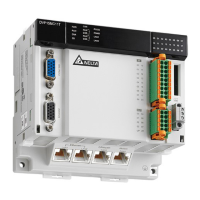DVP-15MC Series Motion Controller Operation Manual
8-318
Step 1: First, set the K
i
and theK
d
to 0. Next, set the KP to 5, 10, 20 and 40 successively, and
record the target values and the process values. The results are shown in the diagram
below.
1.5
1
0.5
0 0.1 0.2 0.3 0.4 0.5 0.6 0.7 0.8 0.9 1 (sec)
K =40
P
K = 20
P
K = 10
P
SV=1
K = 5
P
Time
Step 2: When the KP is 40, there is overreaction. Thus, the KP is not chosen. When the KP is
20, the reaction curve of the PV is close to the SV, and there is no overreaction.
However, due to the fast start-up, the transient output value (MV) is very big. The KP
is not chosen, either. When the KP is 10, the reaction curve of the PV approaches the
SV smoothly. Therefore, the KP is chosen. When the KP is 5, the reaction is too slow.
Thus, the KP is not chosen.
Step 3: After the KP is set to 10, increase the KI. For example, the KI is set to 1, 2, 4, and 8
successively. The KI should not be larger than the KP. Then, increase the KD. For
example, the KD is set to 0.01, 0.05, 0.1, and 0.2 successively. The KD should not be
larger than ten percent of the KP. Finally, the relation between the PV and the SV is
presented in the following diagram.
1.5
1
0.5
0 0. 1 0.2 0.3 0. 4 0.5 0.6 0.7 0.8 0.9 1
Time ( sec)
PV=SV
K =10,K =8,K =0.2
P
I D
Note:
The example is only for reference. Users have to tune the parameters properly according to the practical
condition of the control system
Programming Example
Using the automatic tuning function to control the temperature
Purpose: Using the automatic tuning function to calcaulte the most appropriate parameters
for the PID temperature control
Explanation:
Due to the fact that users may not be familiar with the characteristics of the temperature environment

